My great thanks to Happy Hen Toys for their generosity in providing this figure for review, which is now available for sale at their website happyhentoys.com.

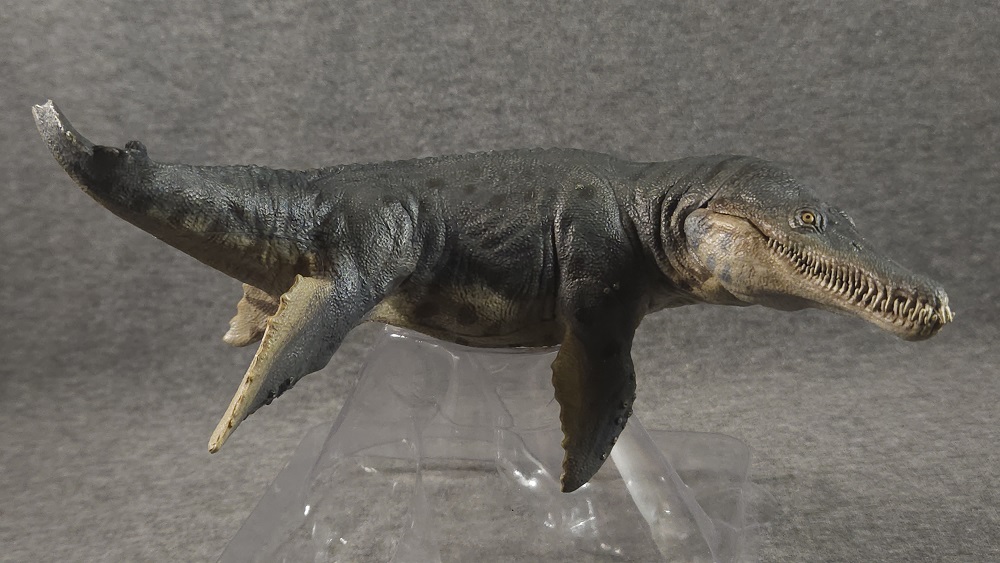
Two whole years after rumors of its existence first began circulating among dino collectors, Papo’s figurine of the Australian apex predator, Kronosaurus queenslandicus, has finally emerged from the realm of myth and begun landing on the shores of retail shops worldwide. Longtime prehistory enthusiasts should know the “Queensland Kronos Reptile” well, it being a well-established genus in literature about Mesozoic marine life. First described in 1924 from the Toolebuc Formation, Kronosaurus is one of Australia’s most famous fossils. The mighty pliosaur roamed the Eromanga sea during the Early Cretaceous, and was likely among the largest predators on the planet when it lived. Although estimates have shrunk the animal over the years, Kronosaurus was still a giant of an animal, reaching up to 10 meters (36 feet) in length and weighing as much as 10 tons. Life on the waves would have been dangerous down under!
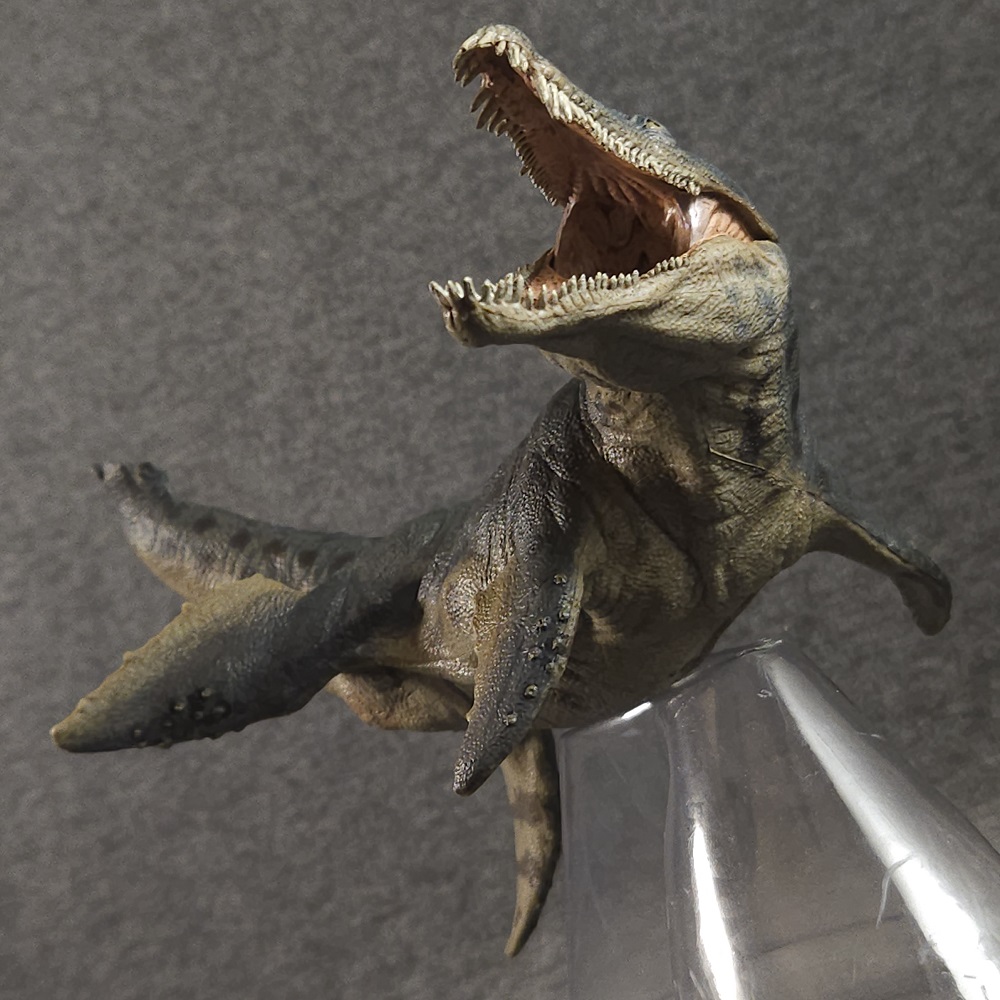
News that Papo was planning a Kronosaurus release was met with intrigue as well as consternation. Once a staple of the dinosaur collecting sphere, many have felt Papo has been in decline over the past years, at least in regards to prehistoric life. Each new lineup seemed to prompt less enthusiasm than it did disappointment, as Papo’s design choices for their dinosaurs and kin seemed to head in a progressively stranger direction. The question, then, was how would Kronosaurus fare? Now that it’s in hand, I am happy to report up front that the famous pliosaur – alongside the Mosasaurus released earlier this year – appears to be a return to form for Papo.
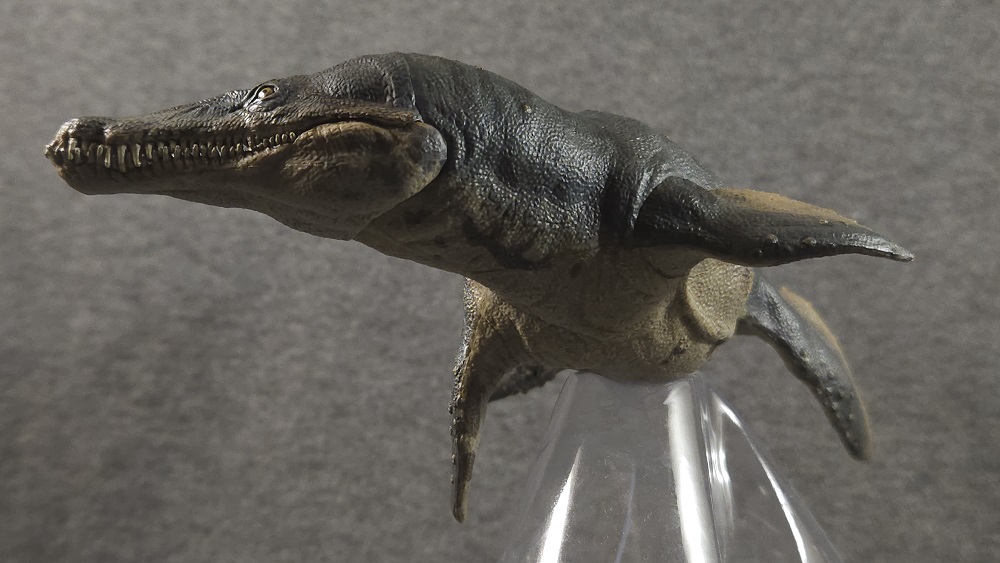
The Papo Kronosaurus is sculpted by Mr. Seo Jung Woon, who has produced many of Papo’s best prehistoric animals over the past decade. The figurine is posed dramatically swerving to the right, perhaps in pursuit of prey (or tearing apart prey already captured?). The figurine can balance on three flippers, although it may tip over forward when its front left flipper is off the ground. Like all Papo carnivores, Kronosaurus has an articulated jaw. Papo was among the very first brands to implement this gimmick; while other companies still struggle sometimes with the engineering today, Kronosaurus opens and shuts its fearsome jaws smoothly and seamlessly* in a range of 30-35 degrees.
*well, technically, one can make out the hinge of the jaw and the seam where the head mold attaches the body – but I’m speaking functionally, of course.
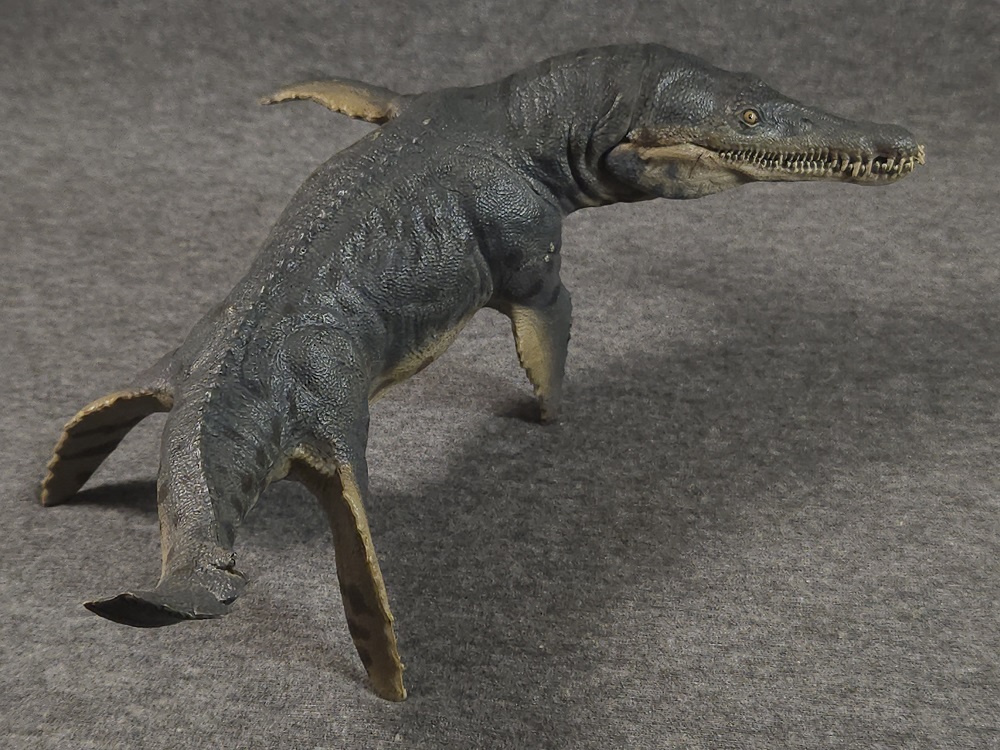
In regards to size, the figurine measures about 22.5 cm (9 in) long from nose to tail, measured roughly along the curve of the spine. The head by itself is 5.5 cm (2.125 in) in length; the front and back flippers are about 5 cm (2 in) and 6 cm (2.25 in) long, respectively. These measurements land the figurine in perfect 1:40 scale, compared to an estimated life size of 9 meters (30 ft) with a skull of 2.21 meters and flippers averaging 2 meters. It’s great to see Mr. Seo Jung Woon took care in accounting for the bodily dimensions of his design, and delivered a model that’s quite realistic to current science (at least in the broad proportions). Not every figure is so diligently measured, even from higher-end collector brands, so this is a welcome surprise from Papo.
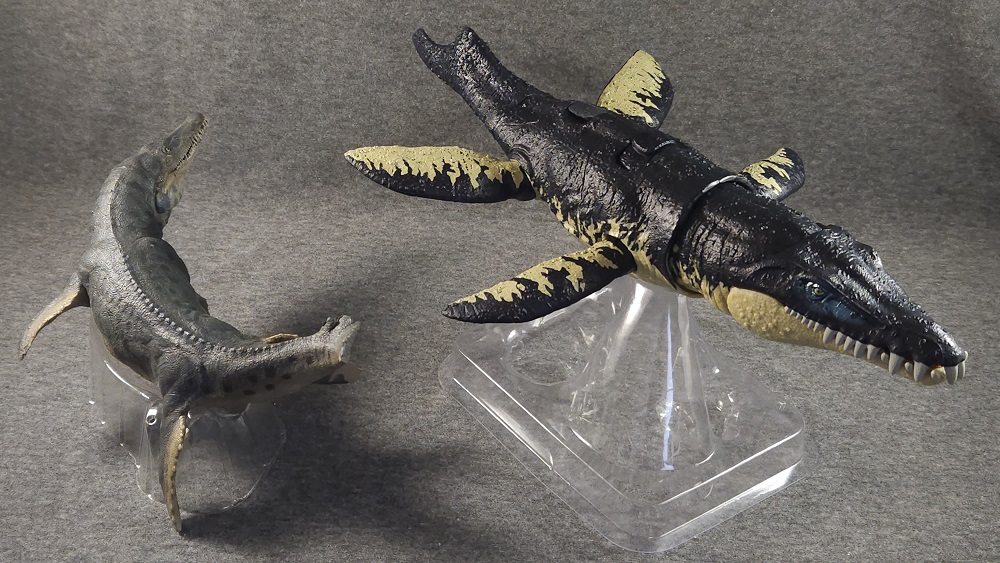
In all fairness, Papo has never approached their extinct animals with strict scientific accuracy in mind – they started out with waves of Jurassic Park knockoffs, after all – so grading the Kronosaurus needs to be done on a curve. The general proportions of the model are great, but scrutiny on the finer details reveals more artistic license. The skull, enormously stretching a quarter of the full model’s length, captures an almost ghoulish appearance with crocodile-like jaws and wide, unfocused gaze. The effect is enticing, but doesn’t feel exaggerated; sea creatures can look pretty weird. The skull’s shape is sharply triangular, with a wide back tapering all the way to the snout, and fairly evenly shallow in lateral view. This is all accurate to fossils… Or, at least mostly. For decades the default image of Kronosaurus has been defined by the skeletal reconstruction mounted in 1959 at Harvard University; but many aspects of this mount have needed correction in literature since.
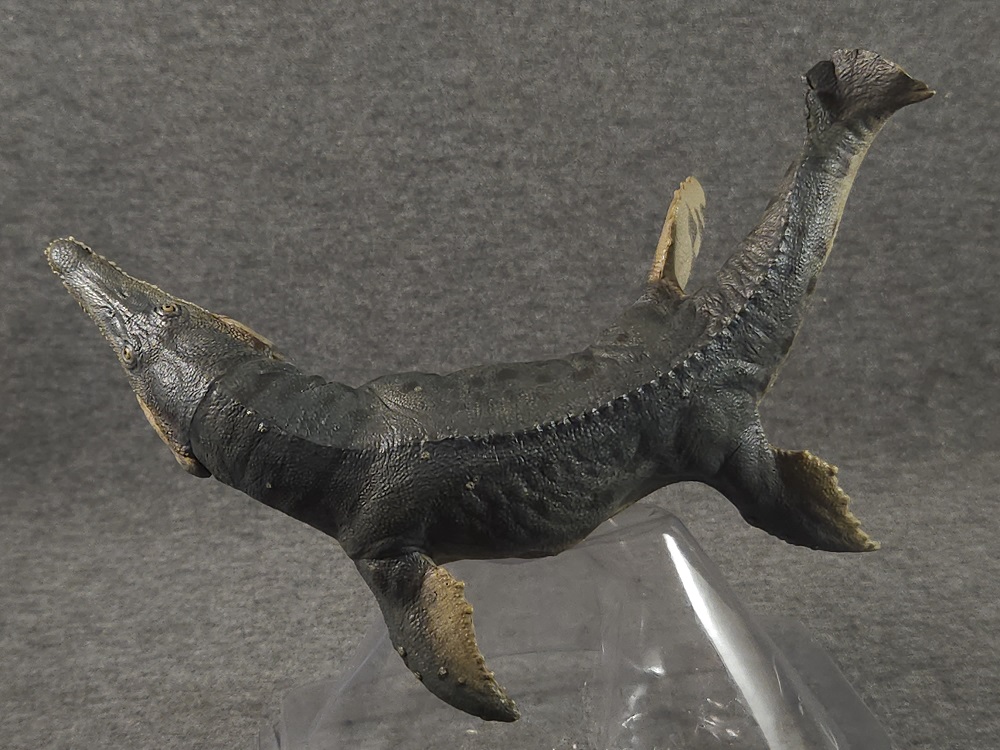
Papo’s Kronosaurus model features something of a mix of features between old and new reconstructions. For a strictly accurate design, the skull should ideally be even flatter in profile, and the triangular shape of the skull should have a more convex curve like the shape of a wishbone, tapering suddenly at the tip of the snout. The jaw, similarly, would show little variation in shape and curve, whereas the Papo model leans into the sinister crocodile-smile look, with a robust jaw hinge. The placements of the eyes and nostrils are accurate, however, with the upwards-angled eyes naturally complimenting the model’s frightening appearance. The tooth count is also accurate, at least in parts: the premaxilla has four pairs of teeth, separated from the maxilla by a subnarial gap, which mesh with five pairs of teeth in the front of the lower jaw (although I count an odd extra tooth, for some reason). The rest of the mouth is also lined with nearly two dozen pairs of interlocking teeth, which gradually reduce in size.
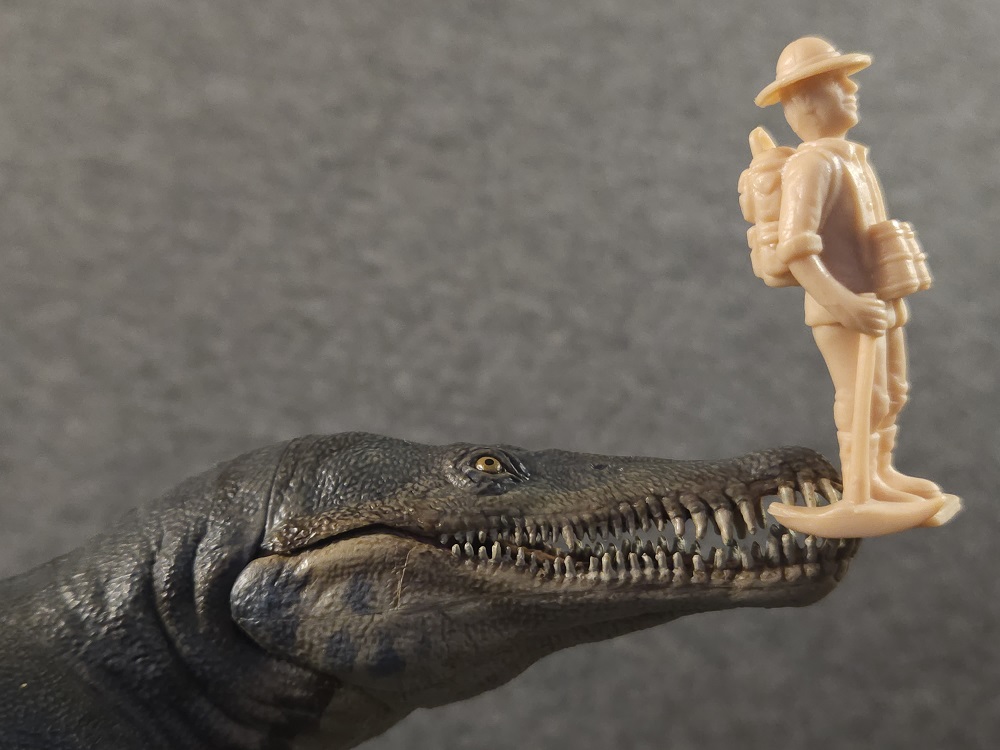
The teeth line up cleanly along the length of the mouth, being arranged mostly vertically rather than splayed out at wide angles; this makes sense for a creature that needs to bite down hard on large prey. Interestingly, while the teeth are fully exposed here in the traditional manner for pliosaur reconstructions, I’ve seen some speculation that Kronosaurus and its relatives might have benefited from lips instead, to reduce potential drag in the water. Whether or not pliosaurs and plesiosaurs could have actually closed their mouths properly with those long, interlocking teeth covered by lips is a mystery yet unsolved, however. Similarly unknown is the nature of the tongue – wait, the tongue, you might ask? Yes, because Papo’s figurine features an inner mouth as detailed as the rest of the sculpt, including a tongue two-thirds the length of the jaw that is, well, kind of human-like in shape. To my knowledge there are no studies on the precise anatomy of pliosaur mouths yet; however I did find at least one mention of hyoid bones in the description of a distantly-related plesiosaur named Meyerasaurus. Observations of the preserved hyoid suggests these marine reptiles might have had tongues similar to modern crocodilians, which are fused to the bottom of the mouth. That certainly sounds fitting given how croc-like Kronosaurus’s visage looks already, at least superficially – I’d guess it would have been easier to sculpt that way, too.
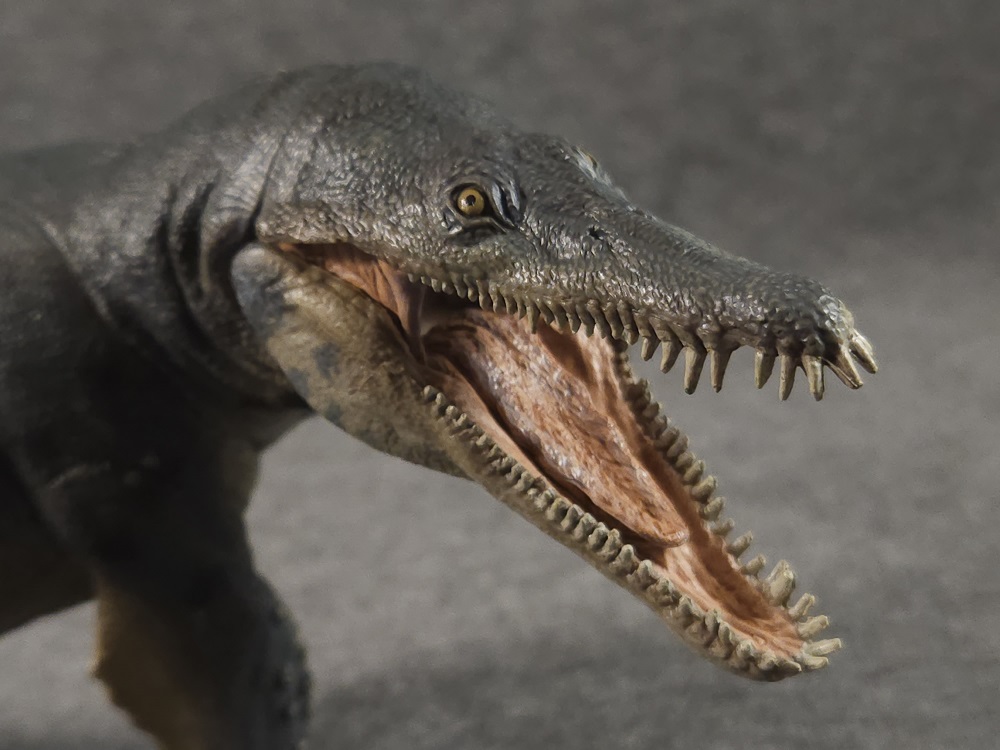
Moving down from the head, Kronosaurus has a robust, short neck for support, attaching to a stout torso. The musculature is splendidly presented here, depicting an animal in peak performing condition. This appearance is a little exaggerated, of course; the body is devoid of fat, when in reality Kronosaurus’s features were likely smoothed out by extra soft tissues. A streamlined body is essential for oceanic predators, to increase swimming efficiency. The ridged backbone of the figurine, though adding detail to the figurine’s rugged silhouette, would likely not be visible in life either. It’s also worth noting that the ribcage is actually deeper than likely for the animal. Unlike deep-chested theropod dinosaurs, marine pliosaurs would have appeared somewhat wide and flat in cross-section. The torso would also have been rigid, so the twisting of the body seen in the figurine might have been less feasible in life. The angle of motion isn’t as extreme as postures seen in some of Papo’s other creatures, however, so the effect at least looks plausible while still being dynamic in appearance.

The flippers are large and roughly triangular in shape, and the hind flippers are correctly the larger pair. In an interesting stylistic choice, the flippers bear tubercles – small outgrowths – on the rear edges of the flippers, giving them a more rough and gnarly appearance. While there isn’t specifically evidence for this feature in pliosaurs, we do see tubercles like these on modern humpback whales – albeit on the leading edges, not the rear edges. Humpbacks can use these tubercles to aid in maneuverability when chasing prey. In a similar fashion, some seals have pronounced claws on their flippers to aid in underwater agility, although it comes at the cost of speed. Would Kronosaurus benefit from bumpy flippers or smooth flippers better? Pliosaurs are usually considered ambush predators, so I would think smooth flippers for straight bursts of speed would be ideal. The image of bumpy flippers is an interesting one, though, and works well with the aesthetic of this model.
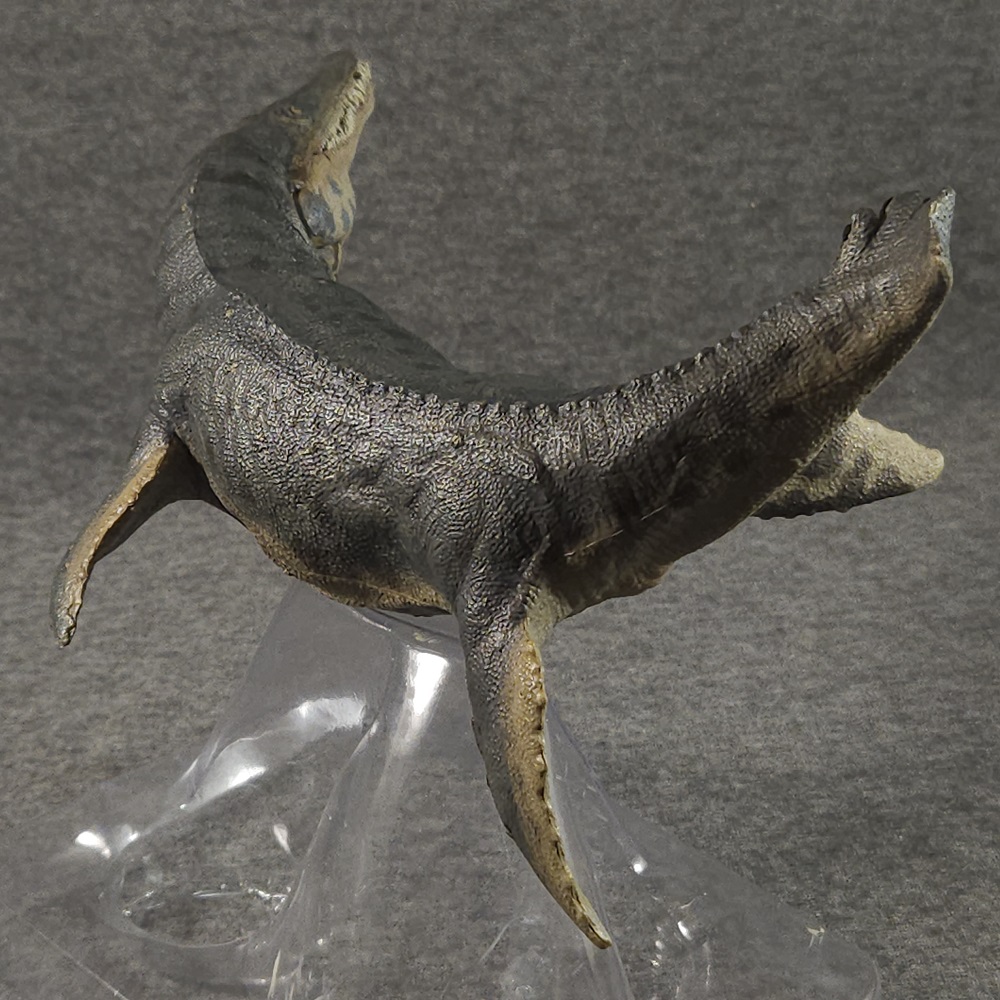
Curving with the contour of the body, the short tail is tipped with a vaguely rounded fin. Pliosaurs and plesiosaurs are known to have definitely featured small tail fins or flukes (though the exact shape[s] remain matters of debate), so once again it is good to see Papo addressing this scientific detail. The fin also shows signs of wear or damage, likely from previous experiences in life, which gives some extra character to this model.
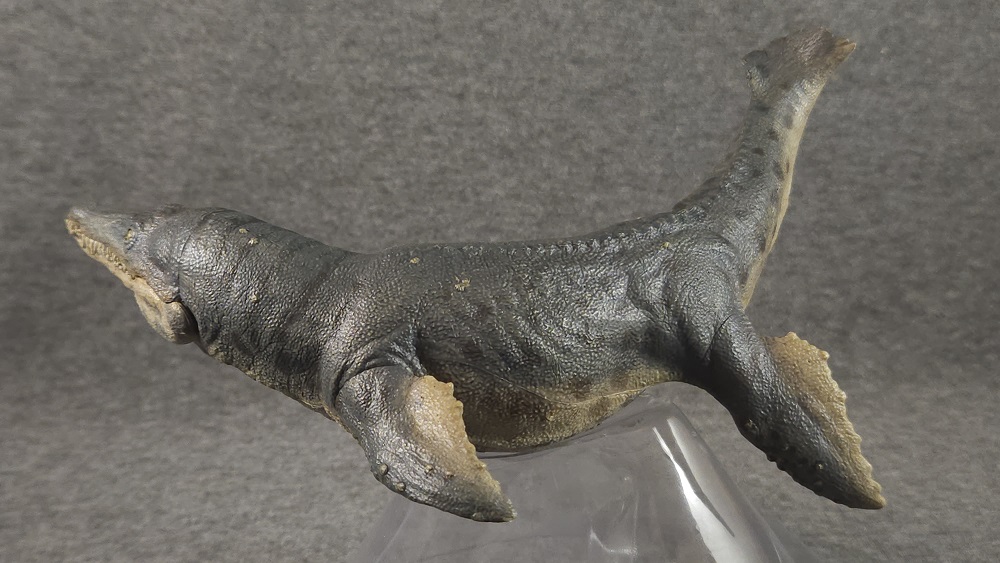
Other details to the sculpt include a covering of very small, rounded scales over the body’s surface. It’s much finer application of skin texture than seen in Papo’s other, older figures – a testament to how Papo has improved their craft (though not every release is consistent). Pliosaur skin texture is another matter of scientific debate, but it’s very likely the skin of Kronosaurus would, scales or no scales, appear very smooth from most distances. For this toy, though, the fine scaling enhances the tactile appeal when being handled. Barnacles also dot the flippers and body in remarkable fashion, adding more personality to this seasoned master of the Cretaceous seas. It certainly seems plausible ancient marine reptiles would have dealt with barnacles and other parasites to some degree, just as whales and sharks deal with them today.
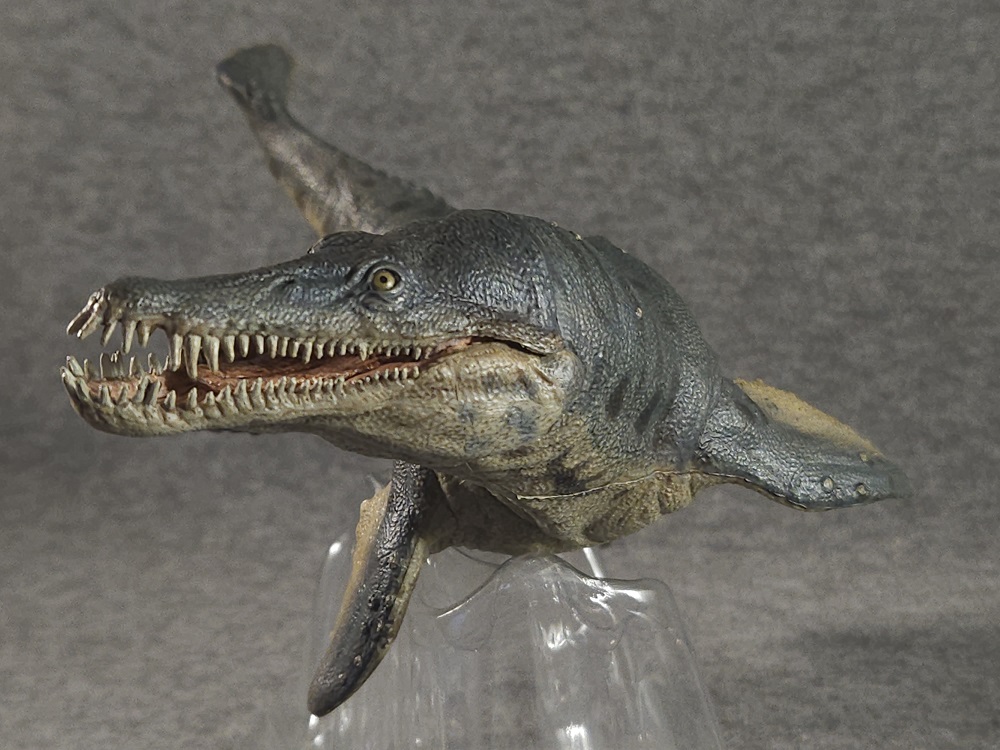
Kronosaurus is countershaded with dark grey-blue and sandy yellow-brown coloration; darker brown spots and splotches pattern the back and belly similar to monitors and crocodiles, sprucing up the model’s appearance in a modest and naturalistic manner. The teeth, all individually sculpted, are neatly painted dirty white, with a grey wash over both the teeth and the inside of the mouth to draw out the details of the sculpt. The beady-looking eyes are yellow and cast an eerie stare befitting a deep-sea “monster”. Of more questionable choice is a reddish wash around the region of the cloaca. I appreciate the attention to anatomical accuracy, but toy companies would probably do better not to draw excessive attention to this feature in such a way. Is our mighty Kronosaurus dealing with, er, some inflammation? Such is the one blight I’d note on this otherwise well-conceived model.
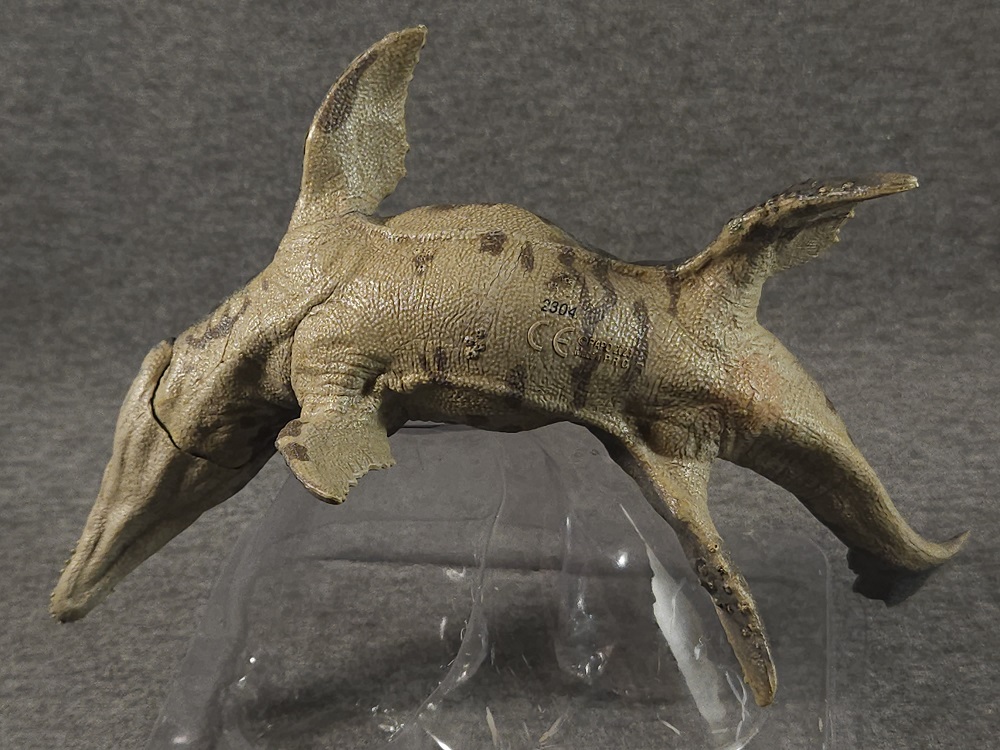
Rule of cool is Papo’s modus operandi for most of their prehistoric animal toys; but where many of their recent efforts have stretched the stylization to the point of absurdity, the 2023 Kronosaurus successfully captures a compromise between artistic license and scientific accuracy, resulting in a figure that’s a delight to handle and behold. For collectors who are stricter about the science, there are better Kronosaurus models on the market already; but longtime fans of the Papo brand will be most satisfied with this replica. This is Papo’s signature prehistoric style at its best.
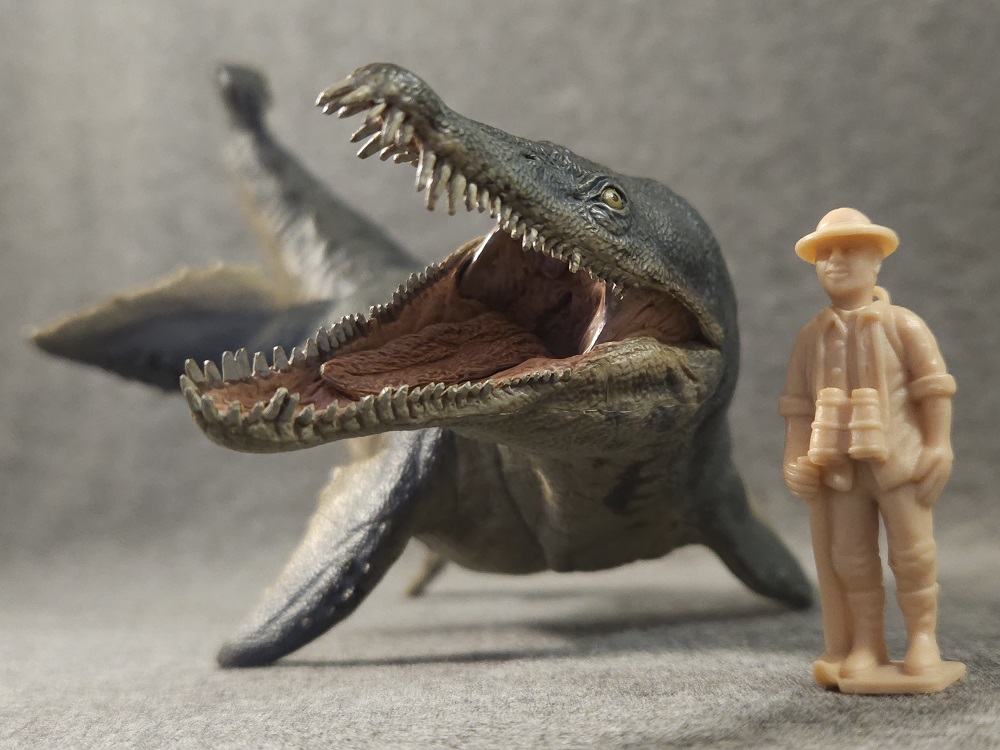
As of this writing Kronosaurus should be available through several online retailers – most notably of which being Happy Hen Toys, who was so gracious as to send me this figure for review. The full 2023 Papo lineup, as well as additional models of Kronosaurus and relatives from other toy brands, are available for purchase at happyhentoys.com.

Disclaimer: links to Ebay and Amazon on the DinoToyBlog are affiliate links, so we make a small commission if you use them. Thanks for supporting us!




I agree — best Papo in many months both in terms of design & sculpt. Great news. But I’m surprised at the uncharacteristically shoddy finish on the teeth. Casting & paint work are not the clean quality I’d expected from them. I’m looking specifically at their 2019 swimming Spino. Beautiful piece.
It is very dangerous looking. Thanks for reviewing it. We’re almost done with the animals featured on the banner in the forum, too!
Easily Papo’s best marine reptile so far. Great review! You got those HHT samples up fast!
Reviews of such quality as this one remind me of the real benefits of this hobby. Thanks so much!
@dinotoyblog This is only Papo's second plesiosaur. I reviewed their first offering in 2010, a Plesiosaurus, but it was really a Plesiosaurus in name only, a huge disappointment: https://dinotoyblog.com/plesiosaurus-papo/ This new plesiosaur is an immense improvement!
I don’t have enough expertise to judge these marine reptiles on accuracy, but I have to admit, Papo’s prehistoric marine reptiles look soooooooooooooooo much nicer than their terrestrial offerings.
I have the Safari Kronosaurus so I wouldn’t get this, but I like it!
BTW, would the Klingon name for this reptile be Qo’noSaurus? 😎